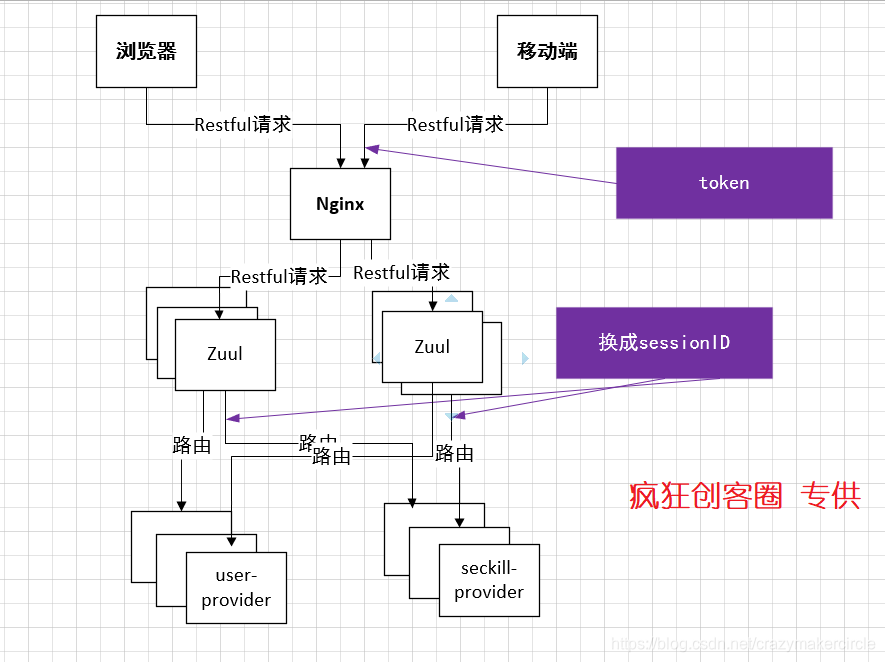SpringSession 独立使用
文章很长,而且持续更新,建议收藏起来,慢慢读!疯狂创客圈总目录 博客园版 为您奉上珍贵的学习资源 :
免费赠送 :《尼恩Java面试宝典》 持续更新+ 史上最全 + 面试必备 2000页+ 面试必备 + 大厂必备 +涨薪必备
免费赠送 经典图书:《Java高并发核心编程(卷1)加强版》 面试必备 + 大厂必备 +涨薪必备 加尼恩免费领
免费赠送 经典图书:《Java高并发核心编程(卷2)加强版》 面试必备 + 大厂必备 +涨薪必备 加尼恩免费领
免费赠送 经典图书:《Java高并发核心编程(卷3)加强版》 面试必备 + 大厂必备 +涨薪必备 加尼恩免费领
免费赠送 经典图书:《尼恩Java面试宝典 最新版》 面试必备 + 大厂必备 +涨薪必备 加尼恩免费领
免费赠送 资源宝库: Java 必备 百度网盘资源大合集 价值>10000元 加尼恩领取
SpringSession 独立使用 的场景和问题
当Zuul网关接收到http请求后,当请求进入对应的Filter进行过滤,通过 SpringSecurity 认证后,提取 SessionID,转发给各个微服务,通过Spring-Session创建的分布式微服务,实现Session共享!
特点:
(1)浏览器和移动端,和Nginx代理,token 是可见的,但是 session 不可见。
(2)各个微服务,用到共享Session,sessionId是可见的。
(3)各个微服务,可以通过自定义的 SessionHolder 共享类,可以静态的取得分布式Session的公共数据,比如基础的用户信息。提升编程的效率。 具体请参见 SpringCloud 开发脚手架。
具体场景的请求处理流程:

问题:
问题一:需要定制ID解析器
场景1 :如果Rest请求从Zuul 过来,Zuul 会在头部设置 sessionID,就是这个场景首先从head中去取
String headerValue = request.getHeader(this.headerName);
场景2: 如果是 单体微服务直接访问 ,就是这个场景 SpringSecurity 会将 sessionID,放在 attribute中。这种场景,直接从从attribute中去取sessionID
headerValue = (String) request.getAttribute(SessionConstants.SESSION_SEED);
SpringSession自带的 ID解析器 ,不能满足要求,需要重新定制一个。关于ID解析器,请参见 疯狂创客圈 的另一博文 SpringSession自带的 ID解析器 最全解读
问题二:需要定制sessionRepository 存储器
sessionRepository 负责存储 session 到Redis,需要修改模式为立即提交,以免setAttribute的属性,不能及时写入Redis,这是笔者调试了几个小时发现的坑
问题三:需要定制SessionRepositoryFilter 过滤器
将Session请求,保持到 SessionHolder 的 ThreadLocal 本地变量中,方便统一获取,方便编程。例如:
SessionHolder.getSessionUser().getLoginName());
直接从redissession,读取用户的名称,多方便呀。
总之: 使用集成的默认的SpringSession ,没有办法深入的解决问题。 有两种方法。
- 第一种是自制 分布式 Session。
具体请参考 疯狂创客圈 博客 分布式RedisSession 自制
这种方法的优点:简陋。 缺点:过于简陋。
在流程和思想上,和第下面的第二种是类似的,可供学习使用,方便理解。
- 第二种是 SpringSession 独立使用。
就是本文的内容。
说明: 第二种在流程和思想上第一种是类似的,可供学习使用,方便理解,建议先了解第一种,第二种就好掌握多了。
理论基础: springSession 原理
spring-session分为以下核心模块:
-
过滤器 SessionRepositoryFilter:Servlet规范中Filter的实现,用 Spring Session 替换原来的 HttpSession,具体的方式是使用了自己的两个包装器: HttpServletRequest 和HttpServletResponse。
-
包装器 HttpServerletRequest/HttpServletResponse/HttpSessionWrapper:包装原有的HttpServletRequest、HttpServletResponse和Spring Session,实现切换Session和透明继承HttpSession的关键之所在
-
Session:Spring Session模块
-
存储器 SessionRepository:负责 Spring Session的存储
具体见下图:
Spring Session模块
spring-session中则抽象出单独的Session层接口,让后再使用适配器模式将Session适配层Servlet规范中的HttpSession。
类图如下:
RedisSession 的本质:
内部封装一个 MapSession,MapSession 本质是一个 map。而 RedisSession 的主要职责:负责 MapSession中 Map 的K-V内容的 Redis 存储。
spring-session 原理,请参见博文
第1步: ID解析器 自定义
场景1 :如果Rest请求从Zuul 过来,Zuul 会在头部设置 sessionID,就是这个场景首先从head中去取
String headerValue = request.getHeader(this.headerName);
场景2: 如果是 单体微服务直接访问 ,就是这个场景 SpringSecurity 会将 sessionID,放在 attribute中。这种场景,直接从从attribute中去取sessionID
headerValue = (String) request.getAttribute(SessionConstants.SESSION_SEED);
实现 HttpSessionIdResolver 接口,定义一个完整的ID解析器,代码如下:
package com.crazymaker.springcloud.standard.config;
//...省略import
@Data
public class CustomedSessionIdResolver implements HttpSessionIdResolver {
private RedisTemplate<Object, Object> redisTemplet = null;
private static final String HEADER_AUTHENTICATION_INFO = "Authentication-Info";
private final String headerName;
/**
* The name of the header to obtain the session id from.
*
*/
public CustomedSessionIdResolver() {
//设置 head头的名称
this.headerName = SessionConstants.SESSION_SEED;
if (headerName == null) {
throw new IllegalArgumentException("headerName cannot be null");
}
}
@Override
public List<String> resolveSessionIds(HttpServletRequest request) {
//step1:首先从head中去取sessionID
// 如果从Zuul 过来,就是这个场景
String headerValue = request.getHeader(this.headerName);
//step1:首先从attribute中去取sessionID
// 如果是 单体微服务直接访问 ,就是这个场景
//SpringSecurity 会将 sessionID,放在 attribute中
if (StringUtils.isEmpty(headerValue)) {
headerValue = (String) request.getAttribute(SessionConstants.SESSION_SEED);
if (!StringUtils.isEmpty(headerValue)) {
headerValue = SessionConstants.getRedisSessionID(headerValue);
}
}
return (headerValue != null) ?
Collections.singletonList(headerValue) : Collections.emptyList();
}
@Override
public void setSessionId(HttpServletRequest request, HttpServletResponse response,
String sessionId) {
//不需要返回sessionId
//到前端
response.setHeader(this.headerName, "");
// response.setHeader(this.headerName, sessionId);
}
@Override
public void expireSession(HttpServletRequest request, HttpServletResponse response) {
response.setHeader(this.headerName, "");
}
//....省略其他
}
第2步:自定义一个SessionRepositoryFilter
这一步,不是必须的。
主要作用: 在过滤器的处理方法 doFilterInternal(....), 要将 redis session 保存到 SessionHolder 类中,方便后面访问。代码如下:
SessionHolder.setRequest(wrappedRequest);
SessionHolder.setSession(wrappedRequest.getSession());
复制源码中的 SessionRepositoryFilter 类,改名为 CustomedSessionRepositoryFilter, 简单的修改一下,代码如下:
package com.crazymaker.springcloud.standard.security.filter;
//.....
public class CustomedSessionRepositoryFilter<S extends Session> extends OncePerRequestFilter {
private static final String SESSION_LOGGER_NAME = CustomedSessionRepositoryFilter.class
.getName().concat(".SESSION_LOGGER");
//....
//默认的ID解析器,需要替换掉
private HttpSessionIdResolver httpSessionIdResolver = new CookieHttpSessionIdResolver();
/**
* Creates a new instance.
*
* @param sessionRepository the <code>SessionRepository</code> to use. Cannot be null.
*/
public CustomedSessionRepositoryFilter(SessionRepository<S> sessionRepository) {
if (sessionRepository == null) {
throw new IllegalArgumentException("sessionRepository cannot be null");
}
this.sessionRepository = sessionRepository;
}
/**
* Sets the {@link HttpSessionIdResolver} to be used. The default is a
* {@link CookieHttpSessionIdResolver}.
*
* @param httpSessionIdResolver the {@link HttpSessionIdResolver} to use. Cannot be
* null.
*/
public void setHttpSessionIdResolver(HttpSessionIdResolver httpSessionIdResolver) {
if (httpSessionIdResolver == null) {
throw new IllegalArgumentException("httpSessionIdResolver cannot be null");
}
this.httpSessionIdResolver = httpSessionIdResolver;
}
@Override
protected void doFilterInternal(HttpServletRequest request,
HttpServletResponse response, FilterChain filterChain)
throws ServletException, IOException {
request.setAttribute(SESSION_REPOSITORY_ATTR, this.sessionRepository);
if(this.servletContext==null)
{
this.servletContext=request.getServletContext();
}
SessionRepositoryRequestWrapper wrappedRequest =
new SessionRepositoryRequestWrapper(request, response, this.servletContext);
SessionRepositoryResponseWrapper wrappedResponse =
new SessionRepositoryResponseWrapper(wrappedRequest, response);
/**
* 将Session请求,保持到 SessionHolder 的 ThreadLocal 本地变量中,方便统一获取
*/
SessionHolder.setRequest(wrappedRequest);
SessionHolder.setSession(wrappedRequest.getSession());
try {
filterChain.doFilter(wrappedRequest, wrappedResponse);
} finally {
wrappedRequest.commitSession();
}
}
public void setServletContext(ServletContext servletContext) {
this.servletContext = servletContext;
}
/**
* Allows ensuring that the session is saved if the response is committed.
*
* @author Rob Winch
* @since 1.0
*/
private final class SessionRepositoryResponseWrapper
extends OnCommittedResponseWrapper {
//.....
}
/**
* A {@link javax.servlet.http.HttpServletRequest} that retrieves the
* {@link javax.servlet.http.HttpSession} using a
* {@link org.springframework.session.SessionRepository}.
*
* @author Rob Winch
* @since 1.0
*/
private final class SessionRepositoryRequestWrapper
extends HttpServletRequestWrapper {
//....
}
static class HttpSessionAdapter<S extends Session> implements HttpSession {
//....
}
}
第3步:自动配置 Configuration 的定制
简单粗暴,将springsession 默认的自动配置,废掉了。
复制一份 RedisHttpSessionConfiguration, 名字叫做 CustomedRedisHttpSessionConfiguration ,主要作用:
(1) 创建 CustomedSessionIdResolver ID解析器的IOC Bean
(2) 创建 sessionRepository 保存器 的IOC Bean时,修改模式为立即提交
package com.crazymaker.springcloud.standard.config;
//....
@Configuration
@EnableScheduling
public class CustomedRedisHttpSessionConfiguration
implements BeanClassLoaderAware, EmbeddedValueResolverAware, ImportAware,
SchedulingConfigurer {
static final String DEFAULT_CLEANUP_CRON = "0 * * * * *";
//......
@DependsOn("httpSessionIdResolver")
@Bean
public RedisOperationsSessionRepository sessionRepository(CustomedSessionIdResolver httpSessionIdResolver) {
RedisTemplate<Object, Object> redisTemplate = createRedisTemplate();
RedisOperationsSessionRepository sessionRepository =
new RedisOperationsSessionRepository(redisTemplate);
sessionRepository.setApplicationEventPublisher(this.applicationEventPublisher);
if (this.defaultRedisSerializer != null) {
sessionRepository.setDefaultSerializer(this.defaultRedisSerializer);
}
sessionRepository
.setDefaultMaxInactiveInterval(this.maxInactiveIntervalInSeconds);
if (StringUtils.hasText(this.redisNamespace)) {
sessionRepository.setRedisKeyNamespace(this.redisNamespace+":"+SessionConstants.REDIS_SESSION_KEY_PREFIX);
}
//修改模式为立即提交
sessionRepository.setRedisFlushMode(RedisFlushMode.IMMEDIATE);
// sessionRepository.setRedisFlushMode(this.redisFlushMode);
int database = resolveDatabase();
sessionRepository.setDatabase(database);
httpSessionIdResolver.setRedisTemplet(redisTemplate);
this.sessionRepository = sessionRepository;
return sessionRepository;
}
//....
/**
* 配置 ID 解析器,从 header 解析id
*
* @return
*/
@Bean("httpSessionIdResolver")
public CustomedSessionIdResolver httpSessionIdResolver() {
return new CustomedSessionIdResolver(SessionConstants.SESSION_ID);
}
}
第4步: 在SpringSecurityConfig中,使用过滤器
package com.crazymaker.springcloud.user.info.config;
//....
import javax.annotation.Resource;
import java.util.Arrays;
@EnableWebSecurity()
public class UserProviderWebSecurityConfig extends WebSecurityConfigurerAdapter {
@Resource
private UserLoginService userLoginService;
protected void configure(HttpSecurity http) throws Exception {
http.csrf().disable()
.authorizeRequests()
.antMatchers(
"/v2/api-docs",
"/swagger-resources/configuration/ui",
"/swagger-resources",
"/swagger-resources/configuration/security",
"/swagger-ui.html",
"/api/user/login/v1",
.permitAll()
.anyRequest().authenticated()
.and()
.formLogin().disable()
.sessionManagement().disable()
.cors()
.and()
.addFilterAfter(new OptionsRequestFilter(), CorsFilter.class)
.apply(new JsonLoginConfigurer<>()).loginSuccessHandler(jsonLoginSuccessHandler())
.and()
.apply(new JwtLoginConfigurer<>()).tokenValidSuccessHandler(jwtRefreshSuccessHandler()).permissiveRequestUrls("/logout")
.and()
.logout()
.addLogoutHandler(tokenClearLogoutHandler())
.logoutSuccessHandler(new HttpStatusReturningLogoutSuccessHandler())
.and()
.addFilterBefore(springSessionRepositoryFilter(), SessionManagementFilter.class)
.sessionManagement().disable()
;
}
@Resource
RedisOperationsSessionRepository sessionRepository;
@Resource
public CustomedSessionIdResolver httpSessionIdResolver;
@DependsOn({"sessionRepository","httpSessionIdResolver"})
@Bean("jwtAuthenticationProvider")
protected AuthenticationProvider jwtAuthenticationProvider() {
return new JwtAuthenticationProvider(sessionRepository,httpSessionIdResolver);
}
//....
}


 浙公网安备 33010602011771号
浙公网安备 33010602011771号